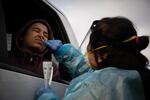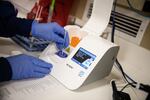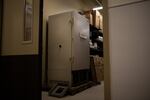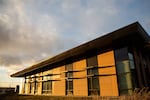
Nurse Rena Wickert administers a COVID-19 test at Yellowhawk Tribal Health Center on the Umatilla Indian Reservation, Monday, Dec. 14, 2020.
Bradley W. Parks / OPB
A pickup truck rolled into the parking lot behind the Yellowhawk Tribal Health Center on the Umatilla Indian Reservation on a recent Monday afternoon. Nurse Rena Wickert grabbed a clipboard and three swabs to test each of the people in the vehicle for the coronavirus.
After Wickert swabbed six nostrils, the truck’s driver waved goodbye and Wickert buzzed back into the clinic. Another nurse collected the swabs and walked them about 10 paces down the hall to the lab, which would kick out test results from a boxy, electronic device.
It takes 15 minutes for a result to come back. If it’s positive, contact tracing begins.
“No way could that happen in a hospital or an emergency room situation,” said Steven Merrill, who is the lab manager and in charge of infection control at Yellowhawk.
Community clinics and health facilities like Yellowhawk are critical to containing the spread of COVID-19. They often stand between sick patients and hospitals, especially in rural areas.
Related: Rural health systems challenged by COVID-19 surge
The speed and accessibility of a nearby clinic, Merrill said, are key to stopping the virus early, long before a patient is sick enough to need emergency services.
“The clinics are very, very important for that frontline access to patients,” he said.
Crisis mode
Since the coronavirus arrived on the reservation in June, Yellowhawk has transformed into a COVID-19 crisis center for the Confederated Tribes of the Umatilla Indian Reservation.
The clinic occupies a unique role in the area health care system and its pandemic response.
Yellowhawk is the primary care provider for Umatilla tribal members and other Native Americans in its service area. It serves an Indigenous population particularly vulnerable to COVID-19 and is surrounded by Oregon’s Umatilla and Union counties, which have had some of the worst coronavirus outbreaks in the state.
The clinic has shifted resources and personnel to take on testing, contact tracing and now vaccinations for the tribe.

Medical technician Michelle Sitz analyzes a COVID-19 test in the Yellowhawk lab. The clinic uses a 15-minute PCR test to turn out results quickly.
Bradley W. Parks / OPB
In many ways, it is well-positioned to combat the virus with access to tests and a lab to analyze results in-house. In other ways, Yellowhawk is like any other rural health clinic or hospital, working with limited staff and resources, which gives the feeling of always operating on the brink.
“We have been overwhelmed,” said Yellowhawk CEO Lisa Guzman. “Our clinic has been extremely strained because we’ve had to require many of our staff members to wear multiple hats.”
Some staff members have had to cut back on their normal duties, if not abandon them entirely, to pitch in with contact tracing.
Related: Oregon contact tracers, health care workers struggle to keep up with caseload
In order for the tribe to receive doses of the Pfizer-BioNTech vaccine, it needed a freezer capable of ultra-low temperatures to store them. The tribe found one in its fisheries department, which had used the freezer to keep lamprey specimens for study but was no longer using it.
“They’re like, ‘Here, we want to be part of the solution,’” said Eric Gabriel, facilities and risk management director at Yellowhawk. “Everyone wants to participate and be part of the solution because this affects everybody.”
Now, the large, gray freezer stands sentinel by the door of Yellowhawk’s bulk storage room, the word “LAMPREY” still scrawled on its side.

An ultra-low-temperature freezer sits in the bulk storage room at Yellowhawk. The fisheries department used it to keep lamprey specimens, but donated the freezer to the clinic to store coronavirus vaccines.
Bradley W. Parks / OPB
Scaling back
About 8% of the clinic’s tests have come back positive. That’s higher than Oregon’s statewide average (5.8%), but about even with the tribe’s Indian Health Service region (8.3%) and lower than Umatilla (13.1%) and Union (10.4%) counties.
Hospitals are filling up across the state as cases surge, which has put the squeeze on rural health systems. These hospitals are the last line of defense against the worst cases of COVID-19, which is why health officials watch their bed capacity closely. An outbreak anywhere could overrun rural hospitals everywhere.
Smaller hospitals like CHI St. Anthony in Pendleton, west of the reservation, rely on transfers to larger hospitals in cities like Bend, Portland or even Seattle when they’re short on beds or don’t have the resources to treat an extremely sick patient.
“If all of those hospitals are full and not able to accept any transfers, then we’re kind of stuck for lack of a better term,” said Emily Smith, CHI St. Anthony’s marketing and communications director.
Smaller clinics play an important role in confronting COVID-19, Smith said. They help keep communities healthy and are also directly easing the pandemic’s burden on hospitals with testing and contact tracing.

The Yellowhawk Tribal Health Center was rebuilt in 2018 and is one of the few Indian health facilities owned and governed by its tribe.
Bradley W. Parks / OPB
Yellowhawk moved into a brand new facility in 2018 with a robust set of offerings. Tribal members come there for everything from primary care to dentistry, behavioral health to pharmacy — all under one culturally sensitive roof. The clinic also offers transportation to treatments or specialized services it can’t provide.
“The patients and the community, they use Yellowhawk for everything for their health,” Gabriel said.
Achieving relatively low coronavirus numbers, however, has meant scaling back a lot of what the clinic offers. It’s cut hours. Optometry is closed and dental is only accepting emergency appointments. Transportation is largely on hold.
“Our community members who come to us on a regular basis have to be extremely frustrated because they’re trying to get in for appointments, they’re trying to follow their continuity of care,” Guzman said.
“Yellowhawk has to work to find a balance between providing daily operational care to the community and then build a whole new COVID clinic that’s going to support the community.”
Related: Oregon vaccine rollout met with cheers — and questions
Guzman said she fears the tribe will fall short on many of its health objectives laid out at the beginning of the year with regard to chronic disease, which is prevalent on the reservation.
The goal right now at Yellowhawk and health facilities everywhere is remaining open and operational while vaccines are rolled out to the masses.
The start of inoculations has been met with relief and excitement (and questions) the world over, including at Yellowhawk. The hallways and the lamprey freezer are humming with news of their impending arrival.
